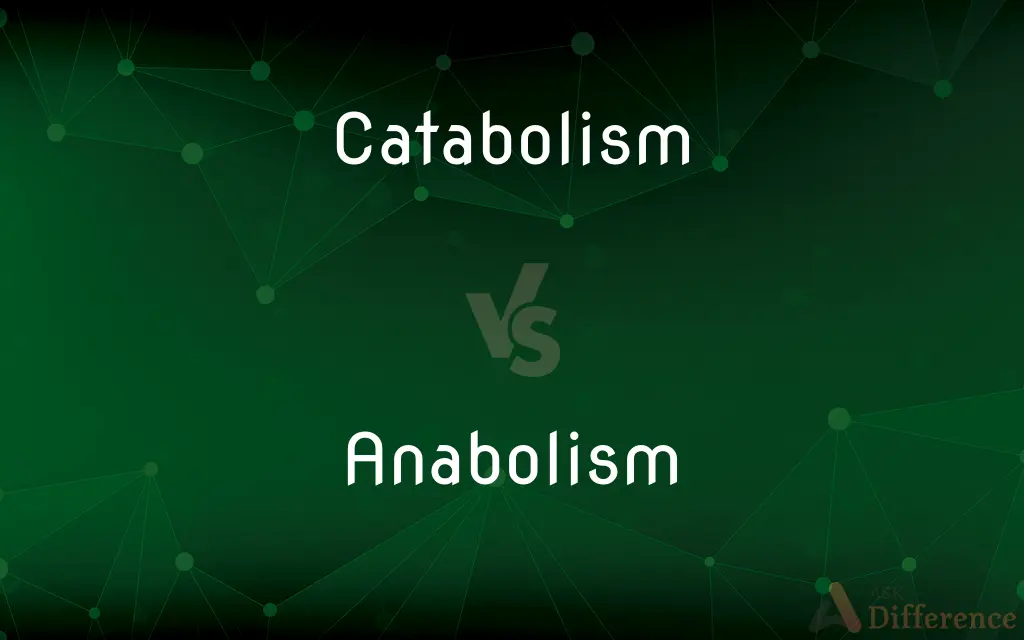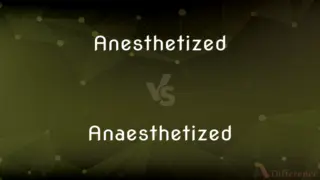Catabolism vs. Anabolism — What's the Difference?
Edited by Tayyaba Rehman — By Urooj Arif — Updated on March 20, 2024
Catabolism breaks down molecules to release energy, while anabolism builds complex molecules from simpler ones, consuming energy.

Difference Between Catabolism and Anabolism
Table of Contents
ADVERTISEMENT
Key Differences
Catabolism is the metabolic process that breaks down molecules into smaller units to release energy, which is vital for cellular activities. While anabolism, on the other hand, refers to the process that builds complex molecules from simpler ones, consuming energy in the process. This energy is often stored in the form of ATP (adenosine triphosphate) during catabolic reactions and then used in anabolic reactions to form complex molecules like proteins and nucleic acids.
Catabolism includes processes like glycolysis, where glucose is broken down to produce energy, and the citric acid cycle, which further processes the breakdown products of glycolysis to release more energy. Whereas anabolism encompasses processes such as protein synthesis, where amino acids are linked together to form proteins, and nucleotide synthesis, which is crucial for DNA replication and repair.
The energy released by catabolic processes is primarily in the form of ATP, which is then used by anabolic processes to form the energy bonds in complex molecules. While catabolism is characterized by its energy-releasing reactions, anabolism is defined by its consumption of energy to synthesize necessary compounds that the cell requires for growth and repair.
Catabolic reactions are often triggered by energy needs of the cell, responding to low energy levels by breaking down complex molecules to release energy. On the other hand, anabolic reactions are driven by the need to repair or grow cell structures, which necessitates the energy-consuming synthesis of complex molecules.
Regulation of catabolism and anabolism is crucial for maintaining cellular homeostasis. Hormones like adrenaline promote catabolism to increase energy availability, while insulin promotes anabolism, facilitating the synthesis of complex molecules for storage and growth.
ADVERTISEMENT
Comparison Chart
Main Function
Breaks down molecules to release energy.
Builds complex molecules from simpler ones.
Energy
Releases energy (ATP).
Consumes energy.
Processes Involved
Glycolysis, citric acid cycle.
Protein synthesis, nucleotide synthesis.
Trigger
Low energy levels in the cell.
Need for cell growth and repair.
Hormonal Regulation
Promoted by hormones like adrenaline.
Promoted by hormones like insulin.
Compare with Definitions
Catabolism
A vital part of metabolism focused on energy release and resource recycling.
Catabolism of fats releases fatty acids used for energy.
Anabolism
The synthesis of complex molecules in living organisms from simpler ones, consuming energy.
Protein synthesis from amino acids is an anabolic process.
Catabolism
Often upregulated in response to energy scarcity.
Exercise increases catabolic activity to provide muscles with sufficient energy.
Anabolism
Stimulated by a need for cell growth or repair.
Insulin promotes glucose anabolism to store energy.
Catabolism
The breakdown of complex molecules in living organisms to form simpler ones, along with the release of energy.
Glucose is broken down into water and carbon dioxide in catabolism.
Anabolism
Supports cell growth, differentiation, and repair.
Bone healing is facilitated by anabolic activities building new tissue.
Catabolism
Provides the energy required for cellular activities and maintenance.
Cellular repair processes are fueled by energy from catabolism.
Anabolism
Essential for growth, repair, and maintenance of body tissues.
Anabolism of nucleic acids is crucial for cell replication.
Catabolism
Catabolism () is the set of metabolic pathways that breaks down molecules into smaller units that are either oxidized to release energy or used in other anabolic reactions. Catabolism breaks down large molecules (such as polysaccharides, lipids, nucleic acids, and proteins) into smaller units (such as monosaccharides, fatty acids, nucleotides, and amino acids, respectively).
Anabolism
Anabolism () is the set of metabolic pathways that construct molecules from smaller units. These reactions require energy, known also as an endergonic process.
Catabolism
The breakdown of complex molecules in living organisms to form simpler ones, together with the release of energy; destructive metabolism.
Anabolism
The synthesis of complex molecules in living organisms from simpler ones together with the storage of energy; constructive metabolism.
Catabolism
The metabolic breakdown of complex molecules into simpler ones, often resulting in a release of energy.
Anabolism
The phase of metabolism in which simple substances are synthesized into the complex materials of living tissue.
Catabolism
(biochemistry) Destructive metabolism, usually including the release of energy and breakdown of materials.
Anabolism
The constructive metabolism of the body, as distinguished from catabolism.
Catabolism
The breakdown of more complex substances into simpler ones with release of energy, in living organisms; destructive or downward metabolism; - a form of metabolism, opposed to anabolism. See also Disassimilation.
Anabolism
The constructive metabolism of the body, as distinguished from catabolism.
Catabolism
Breakdown of more complex substances into simpler ones with release of energy
Anabolism
Synthesis of more complex substances from simpler ones
Common Curiosities
Can you give an example of a catabolic process?
Glycolysis, where glucose is broken down to produce energy, is a catabolic process.
How is the energy from catabolism used in anabolism?
The energy released in catabolism, often in the form of ATP, is used to drive anabolic processes that build complex molecules.
What stimulates anabolic reactions?
Anabolic reactions are stimulated by the need for growth or repair, consuming energy to synthesize complex molecules.
What is an example of an anabolic process?
Protein synthesis, where amino acids are linked to form proteins, is an example of an anabolic process.
How does anabolism contribute to cell growth?
Anabolism contributes to cell growth by synthesizing the complex molecules necessary for cell structure and function.
What is anabolism?
Anabolism is the metabolic process that synthesizes complex molecules from simpler ones, consuming energy.
Can catabolism and anabolism occur simultaneously?
Yes, both processes occur simultaneously in living organisms, carefully regulated to meet the organism's needs.
What is catabolism?
Catabolism is the metabolic process that breaks down complex molecules into simpler ones, releasing energy in the process.
How do catabolism and anabolism differ in terms of energy?
Catabolism releases energy by breaking down molecules, while anabolism consumes energy to build complex molecules.
Why are catabolism and anabolism important?
They are crucial for maintaining life, supporting energy production, growth, and repair of organisms.
What is the impact of exercise on catabolism and anabolism?
Exercise can increase catabolic activity for energy and stimulate anabolic processes for muscle repair and growth.
How are catabolism and anabolism regulated?
They are regulated by hormones, with adrenaline promoting catabolism for energy and insulin promoting anabolism for growth and repair.
How do nutritional needs influence catabolism and anabolism?
Nutritional intake affects both processes, with adequate nutrients supporting anabolic activities and insufficient intake increasing catabolism for energy.
What triggers catabolic reactions?
Catabolic reactions are often triggered by the cell's energy needs, breaking down molecules to release energy.
What role does catabolism play in metabolism?
Catabolism plays a crucial role in metabolism by providing the energy needed for cellular processes and maintenance.
Share Your Discovery

Previous Comparison
Dubstep vs. Electro
Next Comparison
Anesthetized vs. AnaesthetizedAuthor Spotlight
Written by
Urooj ArifUrooj is a skilled content writer at Ask Difference, known for her exceptional ability to simplify complex topics into engaging and informative content. With a passion for research and a flair for clear, concise writing, she consistently delivers articles that resonate with our diverse audience.
Edited by
Tayyaba RehmanTayyaba Rehman is a distinguished writer, currently serving as a primary contributor to askdifference.com. As a researcher in semantics and etymology, Tayyaba's passion for the complexity of languages and their distinctions has found a perfect home on the platform. Tayyaba delves into the intricacies of language, distinguishing between commonly confused words and phrases, thereby providing clarity for readers worldwide.














































